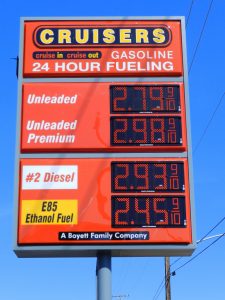
News Item: On April 6, California’s State Legislature Increases Taxes by $5.2 Billion per year through increases on gas tax and vehicle registration.
The twelve cent higher gas tax was pushed through rapidly, before opposition could be mounted. In the long run, the additional money is expected to result in great overall economic benefit to the state. Some citizens will benefit more than others.
In theory, everyone in the Valley wins. Every road in the Valley gets fixed as long as the money doesn’t run out. This assumption is improbable, but possible. When big money goes to state coffers, it is often wasted or diverted. We’ll have to wait and see the outcome.
Those owning businesses in road repair and construction will profit. Their employees will benefit. The general economy will improve from the multiplier effect of the tax expenditures. Economic improvement benefits most citizens, except those retired on fixed incomes; an improved economy often results in rising prices, including higher rents.
Ace Train riders originating in Merced and Stanislaus Counties are big winners as the heavily subsidized rail service will be extended to their communities. Other Valley citizens will see an incrementally small reduction in air pollution as use of Ace Train takes some cars off of the road. However, increases in Ace Train use may be slower than the increase in the number of commuters driving daily from the Valley to the Bay Area, offsetting air quality gains.
Some pundits speculate that the Ace Train will tie the Valley more closely to Silicon Valley as more commuters will choose to take the train to jobs and spend money here at home. Such speculation appears to be similar to trickledown economics, especially when we look at the losers.
Merced will receive funds to complete Campus Parkway, linking Freeway 99 to UC Merced by the shortest distance. This will improve access to the university, the big winner. The City of Merced will benefit by having less traffic drive through town. The reduction in traffic will eventually be offset by future increases in university enrollment, which will result in more students driving around town. More students will result in more economic development in Merced.
Valley Losers
The three main groups that lose the most in the Central Valley are those who drive for a living, commuters, and senior citizens on fixed income who still drive. All three groups will benefit from improved roads, but they also sacrifice the most economically. Farmers complain that they will lose, but their loss will be more than offset by improved roads that will help get their goods to market.
Those who drive for a living will pay considerably more in gas tax and the vehicle registration fee. The higher taxes will be partially offset by lower car maintenance costs. They will also enjoy smoother rides.
Commuters will see their costs increase and also benefit in a manner similar to those who drive for a living. The main drawback could be that the increase gasoline cost for the drive to the Bay Area may cause lower paid workers to quit their jobs and try to find work locally as the commute no longer nets adequate compensation.
Senior Citizens and those on fixed income may endure the most economic pain. They have no means to increase their income but will pay higher taxes and fees. Economic development will also bring higher rents unless they own their home.
Plus or Minus for the Valley?
Whether the net effect of the tax will be beneficial or detrimental remains to be seen. If the Valley receives its full share of tax proceeds, the net could be a plus. If the special funding received for the Ace Train and Campus Parkway causes the Valley to be shortchanged elsewhere, the net effect could be minus.
As examples, Freeway 99 presently needs widening throughout Stanislaus and part of Merced Counties. Route 132 has a toxic waste dump in the right of way that should be removed and a freeway is supposed to eventually be built. The Valley has many roads in need of repair. Will all these needs be funded? We won’t know until the funds are actually received.
Sales Tax Increases for Roads
In recent elections, taxpayers in Stanislaus, San Joaquin, and Merced Counties probably would not have voted themselves sales tax increases to fund road repairs had they known the gasoline tax was about to be raised by twelve cents. The counties are about to experience a bounty of funds for road repair and improvement. Will the bounty be eaten up by corruption or will local governments deliver?
